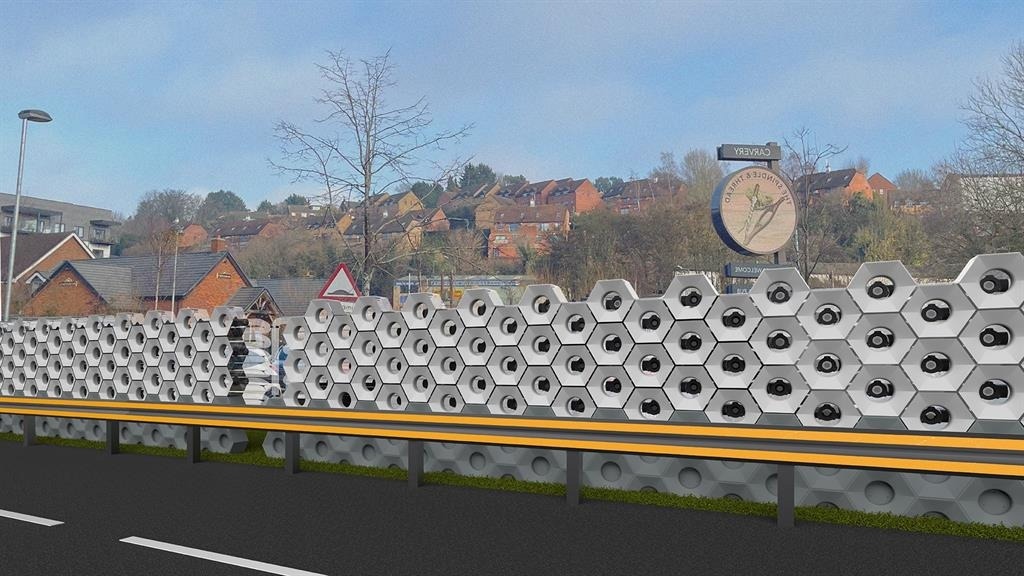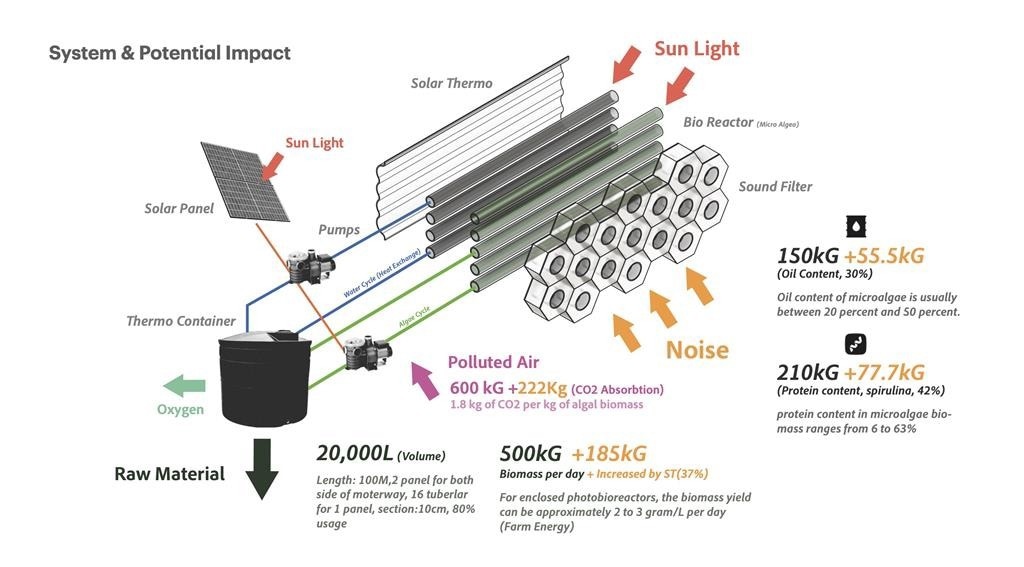In this interview, AZoCleantech speaks with Imperial College London graduate Felix Chen about ALGAEWAVE, a closed-loop autonomous microalgae farming system that uses noise treatment to optimize biomass production. This innovation offers a new approach to generating clean energy while addressing the issue of noise pollution.
Can you please introduce yourself and your professional background?
My name is Felix Chen, and I am a product designer. My projects mainly focus on blending design thinking with engineering innovation to develop projects spanning sustainable agriculture, social innovation, and generative design.
You have applied to this year’s Prototypes For Humanity project, where pioneers in the scientific field are able to showcase their innovations that have the power to change the world. Please can you introduce the project that you have spearheaded as well as its main objectives?
Together with my colleagues Clement Bolle, Bingqin Yang, and Feiyang Xia, we have developed ALGAEWAVE, a system that harnesses urban noise to facilitate microalgae production. We aimed to address urban noise pollution's environmental and health impacts and explore its untapped potential as an energy source.
Our mission is to fuel the world with sound, offering a novel approach to generating clean energy while addressing the issue of noise pollution.
ALGAEWAVE aims to solve several problems in the environmental sector as well as in the microalgae industry. It was also designed to help increase the growth rate and production efficiency of microalgae in terms of biomass production, absorbing the noise, and purifying the polluted air.
What is microalgae, and why is it the focus of your research project?
Microalgae, markedly smaller than macroalgae, are organisms that can grow in aquatic environments and use light and carbon dioxide (CO2) to create biomass. This biomass is convertible into various products such as biofuel, biopolymers, nutrients, and cosmetics, significantly contributing to carbon neutrality goals.
Our decision to use microalgae within our system stems from its accelerated growth rate compared to traditional crops or micro-greens. Our research revealed that noise could, in fact, benefit plant life, particularly by boosting microalgae yields. This attribute positions microalgae as a major asset in green energy initiatives and noise reduction strategies.
What are the key technological innovations in ALGAEWAVE, especially regarding the noise-capturing tweeter and glass resonator? How do these components work together to enhance microalgae growth using urban noise?
Our sound technology plays an important role in converting wide-band noise into specific frequencies conducive to microalgae growth. We have also designed a tweeter to capture noise and a specialized resonator shape cavity to amplify specific frequencies, delivering vibrations to the microalgae.
These targeted frequencies induce mechanical stress on the microalgae cells, enhancing plasma membrane traffic and increasing cellular activity, thereby accelerating their growth.
How does ALGAEWAVE compare to other current methods in microalgae cultivation and environmental management? What advantages does it offer in terms of efficiency, cost, and environmental impact?
ALGAEWAVE is a unique system, utilizing passive methods, more specifically, the vibration from city noise to boost yield by tapping into unused urban spaces such as motorway sides and facades. This autonomous system not only reduces costs but also achieves higher yields compared to existing algae cultivation systems.

Image Credit: Imperial College London
ALGAEWAVE revolutionizes how we approach noise pollution. It ingeniously transforms this noise into an agent for enhancing microalgae growth, raising biomass production by 30% and cutting costs by 27%. Its modular design offers seamless integration into existing photobioreactor systems, promising a swift and flexible implementation.
Besides being a cost-effective solution, ALGAEWAVE also aligns with sustainability goals. It reduces greenhouse gas emissions, promotes renewable energy, and conserves resources, contributing positively to environmental protection.
Moreover, the efficiency gains and inherent versatility of microalgae make ALGAEWAVE invaluable across sectors, from biofuels and biopolymers to biopharmaceuticals, food, and feed production. ALGAEWAVE, thus, represents a unique blend of innovation and sustainability, proving beneficial for the environment, the economy, and varied applications.
What were some of the major challenges you faced while developing ALGAEWAVE, and how were they addressed?
Developing ALGAEWAVE presented several significant challenges, particularly in the sound module segment. The primary difficulty involved experimenting with various technologies to focus and intensify the necessary sound frequencies. This process required us to delve into acoustic lenses and mirrors.
Addressing these challenges involved creating and testing numerous prototypes. Through this iterative process, we identified an optimal shape that significantly enhanced sound efficiency. This shape also facilitated easy stacking, which was a crucial aspect of the design.
Ultimately, the solution was a stackable design that not only achieved high efficiency in sound manipulation but also maintained a low-maintenance profile. This combination of efficiency and practicality was key in overcoming the challenges faced in the development of the sound module for ALGAEWAVE.
How does ALGAEWAVE contribute to environmental sustainability and offer economic advantages over traditional microalgae farming methods? Additionally, how does it align with global goals for renewable energy and resource conservation?
ALGAEWAVE presents new possibilities in microalgae farming. Conventionally, algae farms have been confined to large factories due to the high costs associated with space and maintenance. However, microalgae, as photosynthetic organisms, have immense potential to help overcome this challenge.
Microalgae can capture significantly more CO2 than an equivalent volume of trees, making them a crucial component for the future.
Some architects are already exploring the integration of algae into building facades. Our mission is to elevate ALGAEWAVE to the next level by accelerating algae growth and enhancing both biomass production and oxygen output. This advancement aims to optimize the system's efficiency and effectiveness, contributing significantly to sustainable development and environmental improvement.
This technology opens avenues to produce biofuel utilizing the negative spaces within cities, harnessing the potential of urban negative space.
How versatile is ALGAEWAVE in terms of its applications across different sectors, such as biofuels, biopolymers, and biopharmaceuticals?
ALGAEWAVE boasts considerable versatility in its potential applications across various sectors, including biofuels, biopolymers, and biopharmaceuticals. Its current primary utilization in producing superfoods and supplements is driven by the high margins these products offer, a necessity due to the elevated production costs associated with microalgae.

Image Credit: Imperial College London
To broaden ALGAEWAVE's applicability, particularly in areas like biofuels and biopolymers, there is a critical need to lower production costs, boost output, and increase the lipid content of the algae. Addressing these factors is central to our ongoing efforts, aimed at unlocking the full potential of ALGAEWAVE across a wider range of industries, thereby contributing significantly to sustainable and innovative solutions.
Can you discuss your plans for future collaborations with microalgae farm owners and commercial entities to refine and enhance ALGAEWAVE?
Our future collaboration plans for ALGAEWAVE primarily focus on engaging with microalgae farm owners and commercial entities. Partnering with microalgae farms is crucial to our advancement in research and the development of diverse algae varieties.
Simultaneously, we are exploring collaborations with artists and architects for installations and building facade projects. This approach aligns with our vision of integrating ALGAEWAVE in more public and visible spaces.
However, implementing our modules on highways remains a challenging aspect of our expansion plan. The journey involves navigating through complex safety certifications and diverse regional regulations. Despite these challenges, achieving this implementation is a significant objective for us, aiming to broaden the impact and application of ALGAEWAVE in public infrastructure.
What is your long-term vision for AlgaeWave, and how do you see it evolving over the next few years?
Our long-term vision for ALGAEWAVE is centered around creating a sustainable, self-sufficient ecosystem. The key objective is to develop a closed-loop system wherein biopolymers derived from our biomass production are used to manufacture new ALGAEWAVE modules. This approach will significantly contribute to the scalable and sustainable expansion of the technology.
In the coming years, we plan to initiate this vision on a smaller scale, starting with installations and building facades and gradually progressing to incorporating ALGAEWAVE into broader infrastructural projects. This phased approach will allow us to refine and adapt our technology in various settings.
We are also encouraged by the increasing trend of using microalgae as an alternative to traditional plants in numerous applications. This shift aligns perfectly with our vision, offering a promising avenue for ALGAEWAVE to evolve and become an integral part of various industries and infrastructures in the near future.
About Felix Chen
 Felix Chen is a product designer and social innovator working across disciplines. His projects focus on coffee innovation, generative design, and social issues such as surveillance and human rights. As part of his final year project, he wishes to make a significant contribution to the coffee industry.
Felix Chen is a product designer and social innovator working across disciplines. His projects focus on coffee innovation, generative design, and social issues such as surveillance and human rights. As part of his final year project, he wishes to make a significant contribution to the coffee industry.
Disclaimer: The views expressed here are those of the interviewee and do not necessarily represent the views of AZoM.com Limited (T/A) AZoNetwork, the owner and operator of this website. This disclaimer forms part of the Terms and Conditions of use of this website.